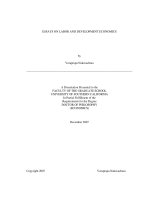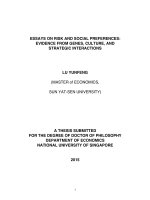ESSAYS ON RISK AND SOCIAL PREFERENCES EVIDENCE FROM GENES, CULTURE, AND STRATEGIC INTERACTIONS
Bạn đang xem bản rút gọn của tài liệu. Xem và tải ngay bản đầy đủ của tài liệu tại đây (10.36 MB, 139 trang )
!
i!
ESSAYS ON RISK AND SOCIAL PREFERENCES:
EVIDENCE FROM GENES, CULTURE, AND
STRATEGIC INTERACTIONS
LU YUNFENG
(MASTER of ECONOMICS,
SUN YAT-SEN UNIVERSITY)
A THESIS SUBMITTED
FOR THE DEGREE OF DOCTOR OF PHILOSOPHY
DEPARTMENT OF ECONOMICS
NATIONAL UNIVERSITY OF SINGAPORE
2015
!
ii!
DECLARATION
I hereby declare that this thesis is my original
work and it has been written by me in its entirety. I have
duly acknowledged all the sources of information which
have been used in the thesis.
This thesis has also not been submitted for any
degree in any university previously.
_________________________
!
iii!
Acknowledgements
No man is an island. I would like to thank all the people who
provided support and help throughout my PhD study.
My main supervisor Chew Soo Hong gave me a role model to be a
researcher who can find ideas independently, observe high intellectual
standard, focus on the details, and refine his work relentlessly. Under his
supervision, I learned how to do research rigorously. His support is the
most important factor that made this thesis possible.
Professor Richard Ebstein shared with me his research passion
and deep insights from biology. His intellectual input is indispensible for
my interdisciplinary research. I really appreciate his help and support in
these years.
I would also thank Professor Jessica Pan, Chong Juin Kuan,
Zhong Songfa, and Lu Yi. They gave me numerous suggestions in my
PhD study, broadened my research toolbox, and sharpened my research
skills.
My friends provided a lot of comments and encouragement in my
research and daily life. Zhang Xing, Qian Neng, Li Jingping, Jiang Yushi,
Shen Qiang, Xie Huihua, and Miao Bin, thank you!
Finally I would like to thank my wife Hu Shu. I met her in our PhD
study years, and we supported each other in our research journeys. These
years are the best days in my life.
!
iv!
Table of Contents
Summary vii
List of Tables ix
List of Figures xi
1 Peripheral Serotonin Receptor 2A (HTR2A) Gene Expression and
Financial Risk Preferences: Association with Loss Aversion,
Anxiety-Related Personality Traits and Polymorphism 1
1.1 Introduction ………………………………………………………………. 1
1.2 Materials and Methods …………………………………………………. 7
1.2.1 Experimental Tasks ………………………………………………… 7
1.2.2 Lab Procedures for DNA Genotyping and Gene Expression ……. 8
1.3 Results ………………………………………………………………… 9
1.3.1 Data ……………………………………………………………………. 9
1.3.2 Econometric Models …………………………………………………. 11
1.3.3 Estimation Results …………………………………………………… 13
1.3.4 Robustness Checks …………………………………………………. 16
1.3.5 Evidence from Personality Traits ………………………………… 19
1.3.6 HTR2A Expression and Genetic Variation ………………………… 22
1.4 Discussion ………………………………………………………………. 26
!
v!
1.5 Appendix ………………………………………………………………… 37
1.5.1 Appendix A: Experimental Instructions ……………………………. 37
1.5.2 Appendix B: Ordered Logit Regression Results …………………. 43
2 The Rice Culture Theory of Cooperative Behavior: Evidence from
Incentivized Decision Making Tasks in China 44
2.1 Introduction ……………………………………………………………… 44
2.2 Literature ………………………………………………………………… 47
2.3 Results ………………………………………………………………… 53
2.3.1 Empirical Strategy …………………………………………………. 53
2.3.2 Evidence from Incentivized Experimental Games ……………… 54
2.3.3 Evidence from China Family Panel Studies Data ……………… 69
2.3.4 Discussion ……………………………………………………………. 76
2.4 Conclusions …………………………………………………………… 80
2.5 Appendix .…………………………………………… ……………… 78
2.5.1 Appendix A: Instructions for Behavioral Experiments ………… 78
2.5.2 Appendix B: First Stage Results of Instrumental Regression of the
Public Goods Game ………………………………………………………… 87
2.5.3 Appendix C: Results of Trustworthiness in the Trust Game ……. 88
3 Does the Stake Size Matter in Penalty Kick? - An Experimental
Investigation of the Two-Stage Matching Pennies Game 89
3.1 Introduction …………………………………………………………… 89
!
vi!
3.2 Experimental Design ………………………………………………… 93
3.3 Theoretical predictions ……………………………………………… 95
3.4 Results …………………………………………………………… … 100
3.4.1 Equilibrium Frequencies and the Stake Size Effect ……… … 100
3.4.2 Asymmetry of Player Roles …………………………….…… … 103
3.4.3 Serial Correlation ………………….………………………… … 103
3.5 Discussion …………………………………………………………… 104
3.6 Conclusions ……………………………………………………………. 107
3.7 Appendix …………………………………….…………………………. 109
3.7.1 Appendix Table A1 Pair Level Data ………………………………. 109
3.7.2 Appendix Table A2 Serial Correlation Results … ………………. 111
3.7.3 Appendix Table A3 Group Level Frequency Data with All
Subjects … ……………………………………………………………… 113
3.7.4 Appendix Table A4 Between Subject Comparison with All
Subjects … …………………………………………………………… …. 113
3.7.5 Appendix A5: Instructions for the Experiment .………… ………. 114
Bibliography 116
!
vii!
Summary
Risk and social preferences are the fundamental blocks in
behavioral economics. The three essays in this dissertation study people’s
risk and social preferences from an empirical and experimental
perspective. We use biological data, in addition to observable choice data
and field data, to investigate the determinants of risk and social
preferences as well as factors that may influence people’s behavior in
several decision making settings.
In Essay 1, we examine how the level of serotonin receptor 2A
(HTR2A) gene expression in blood influences people’s risk attitude elicited
in incentivized decision making tasks. We estimate structural models of
prospect theory, and show that HTR2A is associated with the loss
aversion parameter. The additional results of association between HTR2A
and two personality measures Neuroticism as well as Harm Avoidance
gave further support for the main finding. Finally we validated the blood
genomics approach by showing that Single Nucleotide Polymorphism
(SNP) variation is correlated with overall HTR2A expression.
In Essay 2, we investigate the rice culture hypothesis using the
observed choice behavior for several experimental economics games in
China. It has been proposed (Talhelm et al., 2014) that a history of rice
farming makes cultures more interdependent while wheat farming makes
cultures more independent, and that these longstanding agricultural
!
viii!
practices continue to influence cultures into the modern era. We find that
the difference of cooperative behavior in the public goods game is
explained by the extent of rice culture locally, proxied by the proportion of
land used for rice farming. The rice culture theory is further corroborated in
examining non-choice data relating to cooperativeness from a national
representative survey data, China Family Panel Studies.
Essay 3 studies behavior in a two-stage matching pennies game
where players face both objective risk and strategic uncertainty. We
examine the effect of varying stake size in an experimental setting and
show that the observed stake-size effect can be compatible with
equilibrium behavior derived from recursive expected utility theory or
quantal response model, but not from a standard expected utility
specification.
!
ix!
List of Tables
Table 1.1 Choices in the Five Tasks ………………………………………. 8
Table 1.2 Summary Statistics ……………………………………………… 10
Table 1.3 Switching Points in the Five Tasks ……………………………. 11
Table 1.4 Structural Estimation of Prospect Theory …………………… 15
Table 1.5 Structural Estimation by Gender Subsample ……… ……. 16
Table 1.6 Alternative Probability Weighting Functions …………………. 18
Table 1.7 Alternative Risk Tasks …………………………………………. 19
Table 1.8 Ordered Logit Regression Results ………………………… 43
Table 2.1 Sample Distribution across Provinces ……………………… 58
Table 2.2 Summary Statistics …………………………………………… 59
Table 2.3 Average Contribution in the Public Goods Game ………… 59
Table 2.4 OLS and IV Estimates of The Public Goods Game ………… 61
Table 2.5 The Trust Game ……………………………………………… 62
Table 2.6 Controlling for Risk …………………………………………… 63
Table 2.7 IV Estimates of the Modified Dictator Game ………………… 65
Table 2.8 Person B’s Choice of Left in the Sequential Game …………. 67
Table 2.9 Person B’s Choice of Right in the Sequential Game ……… 68
Table 2.10 Get and Give Help ……………………………………………. 70
Table 2.11 Social Interaction ……………………………………………… 72
Table 2.12 Village Expenditure …………………………………………… 74
!
x!
Table 2.13 Economic Growth and Rice Farming ………………………. 75
Table 2.14 Modernization Hypothesis ………………………………… 77
Table 2.15 Death Rate of Infectious Diseases …………………………. 79
Table 2.16 Distance to Beijing …………………………………………… 80
Table 3.1 Group Level Frequency Data ……………………………… 101
Table 3.2 Between Subject Comparison ……………………………… 102
Table 3.3 Comparisons of Theories and Evidence …………………… 106
Table 3.4 The Stake Size Effect in QRE ………………………………. 107
Table A1 Pair Level Data ………………………………………………… 109
Table A2 Serial Correlation ……………………………………………… 111
Table A3 Group Level Frequency Data with All Subjects. …… …… 113
Table A4 Between Subject Comparison with All Subjects … …… …. 113
!
xi!
List of Figures
Figure 1.1 The Scatter Points of Neuroticism and HTR2A …………… 21
Figure 1.2 The Scatter Points of Harm Avoidance and HTR2A ………. 21
Figure 1.3 The Scatter Points of NEO Neuroticism and λ …………… 22
Figure 1.4 The Scatter Points of Harm Avoidance and λ ……………… 22
Figure 1.5 LD Plot of HRT2A eQTLs in Blood ………………………… 23
Figure 1.6 HTR2A Expression and rs6311 Genotype in Blood ……… 25
Figure 1.7 Scree Plot of PCA of HTR2A eQTLs ……………………… 26
Figure 2.1 Map of the People’s Republic of China …………………… 58
Figure 2.2 The Sequential Game ………………………………………… 67
Figure 2.3 Economic Growth Rate Correlates with Rice Farming Ratio 75
Figure 3.1 Two-stage Matching Pennies Game ………………………… 90
Figure 3.2 Quantal Response Equilibrium with Variation in λ ………… 99
Figure 3.3 Learning Dynamics ……………………………………… …. 103
!
1!
Chapter 1
Peripheral Serotonin Receptor 2A (HTR2A) Gene
Expression and Financial Risk Preferences:
Association with Loss Aversion, Anxiety-Related
Personality Traits and Polymorphism
1
1.1 Introduction
Across lifespans as individuals, and as a species, humans from
their very beginnings on the savannahs of East Africa have been faced
with decisions, which invariably involve some risk. Indeed decision-making
under risk to this day is ubiquitous in our daily life. Some people invest in
risky financial markets weighing the chance of gain and loss whereas
other keep their money in low yielding bonds and bank deposits. Some
people go for the longshot and bet on the state lottery but also buy
insurance to avoid the low risk of rare events such as earthquakes. Facing
these decisions, people vary greatly in their risk attitude. Some of us avoid
risks if at all possible, whereas others are risk prone seeking out risky
financial investment and the longshot gamble.
!!!!!!!!!!!!!!!!!!!!!!!!!!!!!!!!!!!!!!!!!!!!!!!!!!!!!!!!
1
This is a joint work with Mikhail Monakhov, Poh San Lai, Soo Hong Chew, and Richard
Ebstein. We thank Anne Chong, Zhang Xing, and Tang Rong for assistance in data
collection, Mikhail Monakhov, Aileen Pang Yu Wen, Lye Hui Jen, Xiong Gaogao, Zhu
Qingdi and Ping Yuan – for assistance in DNA extraction and genotyping, Roy Chen,
Song Changcheng, and Zhong Songfa for insightful comments and suggestions in the
data analysis. This study was supported by grants from AXA Research Fund ("The
Biology of Decision Making under risk"), John Templeton Foundation (ID: 21240),
Singapore Ministry of Education (“The Genetic, Neuroimaging and Behavioral Study of
Human Decision Making”) and National University of Singapore (“Decision Making Under
Urbanization: A Neurobiological and Experimental Economics Approach” and Start-Up
grants to R.P.E. and S.H.C.).
!
!
2!
To understand such complex choice behaviors under risk, several
generations of social scientists have developed theories intended to
capture the common features of decision-making but also accommodating
the widespread observed individual differences in people’s behavior. The
most important of these theories is expected utility theory developed by
John von Neumann and Oscar Morgenstern (1944). The theory assigns a
utility number to each possible outcome in a gamble, and adds each
gamble by weighing the probability of its occurrence. It uses an index of
curvature in the utility function to measure individual differences in risk
attitude. The theory is widely accepted in social sciences, and has found
numerous applications. However, accumulating empirical evidence such
as the Allais Paradox (Maurice Allais, 1953), challenged the expected
utility theory as a complete explanation of real-life human choice behavior.
Several non-expected utility theories (Chris Starmer, 2000) have emerged
as alterative hypotheses and among the most important and influential is
prospect theory (PT). Kahneman and Tversky (Daniel Kahneman and
Amos Tversky, 1979, Amos Tversky and Daniel Kahneman, 1992)
proposed in prospect theory to include loss aversion and probability
weighting towards a deeper understanding of human decision-making.
Prospect theory has generated a vast literature enabling a fuller
appreciation of choice behavior under risk.
More recently, studies of financial risk attitude have taken a
biological turn and explanations at the neural level (J. C. Dreher, 2007, M.
!
3!
Hsu et al., 2005, B. Knutson and P. Bossaerts, 2007, B. Knutson and S.
M. Greer, 2008, S. M. Tom et al., 2007, S. Zhong et al., 2012) have been
sought towards a richer understanding of the brain regions underpinning
decision-making. Many of these later investigations have leveraged
behavioral economic tasks coupled with neural imaging and neurogenetic
approaches spawning two emerging disciplines, neuroeconomics (C. F.
Camerer, 2007, G. Loewenstein et al., 2008, R.P. Montague, 2007) and
more recently, genoeconomics (D. J. Benjamin et al., 2012, DJ Benjamin
et al., 2007, R. P. Ebstein et al., 2010, A. Navarro, 2009). Neurogenetic
approaches to better understand financial decision-making have
provisionally identified elements of dopaminergic (A. Dreber and C. L.
Apicella, 2009, C. Frydman et al., 2011, C. M. Kuhnen and J. Y. Chiao,
2009) and serotonergic (L. G. Crisan et al., 2009, K. Doya, 2008, C. M.
Kuhnen and J. Y. Chiao, 2009, C. M. Kuhnen et al., 2013) neural
transmission as likely playing a role in choice behavior involving risk.
These neurogenetic approaches have tentatively identified
candidate genes such as the dopamine receptor type 4 (DRD4) (A. Dreber
and C. L. Apicella, 2009, C. M. Kuhnen and J. Y. Chiao, 2009), the
serotonin transporter (SLC6A4) (C. M. Kuhnen, G. R. Samanez-Larkin and
B. Knutson, 2013) and monoamine oxidase A (MAOA) (C. Frydman, C.
Camerer, P. Bossaerts and A. Rangel, 2011, S. Zhong et al., 2009a) as
contributing to financial risk attitude. However, given the moderate
heritability of most complex traits, in which environment plays an important
!
4!
role, the sole pursuit of genetic markers alone may fail to reveal the
fullness of phenotypic variance (T. A. Manolio et al., 2009, M. H. van
Ijzendoorn et al., 2011). A complimentary approach is to measure
biomarkers (D. S. Tylee et al., 2013) in accessible tissues such as blood.
Gene expression, which reflects both hereditable and environmental
influence, is a particularly attractive target. Measurement of mRNA levels
is likely to capture more of the phenotypic variance, both genomic and
epigenetic than a unitary gene based approach. Most importantly,
expression levels of many genes show good correspondence between
peripheral blood and brain (I. S. Kohane and V. I. Valtchinov, 2012, B.
Rollins et al., 2010, P. F. Sullivan et al., 2006, D. S. Tylee, D. M.
Kawaguchi and S. J. Glatt, 2013, C. H. Woelk et al., 2011). These
considerations have catalyzed an increasing number of investigations
demonstrating a relationship between peripheral transcription of both
specific candidate genes as well as whole genome expression and many
behavioral syndromes (M. Ayalew et al., 2012, Stephen J. Glatt et al.,
2012, Stephen J. Glatt et al., 2013, S. M. Kurian et al., 2011, Y. Kuwano et
al., 2011, H. Le-Niculescu et al., 2007a, H. Le-Niculescu et al., 2009, H.
Le-Niculescu et al., 2007b, D. Mehta et al., 2011, M. Uddin et al., 2010, G.
Ursini et al., 2011, Z. Yi et al., 2012). Indeed, so-called ‘blood genomics’ is
becoming an important tool in dissecting complex behaviors. However, no
studies to our knowledge have yet leveraged blood genomics towards
understanding financial decision-making.
!
5!
In the influential article of P. F. Sullivan, C. Fan and C. M. Perou
(2006), the authors cautiously note that gene expression in blood “is
neither perfectly correlated and useful nor perfectly uncorrelated and
useless with gene expression in multiple brain tissues”. They suggest that
a circumspect employment of mRNA measurements in blood may index
gene expression in some brain regions when it is certain that the gene of
interest is expressed in both tissues. One of the genes specifically noted
by them is the serotonin 2
A
(5-HT
2A
) receptor (HTR2A). HTR2A is
expressed in both prefrontal cortex and whole blood suggesting that
measurement of whole blood HTR2A mRNA levels would be a good
surrogate for brain expression. The 5-HT
2A
receptor has been the focus of
keen interest in human behavioral studies including studies of
schizophrenia (B. H. Ebdrup et al., 2011), borderline personality disorder
(U. W. Preuss et al., 2001), mood disorders (L. Gu et al., 2013),suicidal
behavior (N. Antypa et al., 2013) and aggression (Sophie da Cunha-Bang
et al., 2013). Evidence from a variety of sources especially links 5-HT
2A
to
schizophrenia. For example, 5-HT
2A
receptors have been a suggested as
targets for atypical neuroleptic drugs (H. Y. Meltzer, 2012, T. A. Mestre et
al., 2013); dysregulated 5-HT
2A
receptor regulation as well as mRNA
synthesis has been observed in schizophrenia (A. L. Lopez-Figueroa et
al., 2004, C. Muguruza et al., 2013); receptors mediates the hallucinogenic
effects of psilocybin (M. Kometer et al., 2013); and a meta-analysis of
HTR2A polymorphisms suggests association with schizophrenia (G. Blasi
!
6!
et al., 2013, L. Gu, J. Long, Y. Yan, Q. Chen, R. Pan, X. Xie, X. Mao, X.
Hu, B. Wei and L. Su, 2013). Beyond the evidence linking this receptor to
abnormal behavior there are good reasons to expect that 5-HT
2A
also has
an important role in normal behavior including financial decision-making.
Firstly, the 5-HT
2A
receptors are important in the regulation of brain
dopamine (DA) transmission particularly in the mesocorticoaccumbens DA
pathway, which originates in DA somata of the ventral tegmental area
(VTA) and terminates in the nucleus accumbens (NAc) and prefrontal
cortex (PFC) (M. J. Bubar and K. A. Cunningham, 2006). This system is
crucial in reinforcement learning and brain reward pathways. 5-HT
2A
receptors are mainly located post-synaptically and they provide stimulatory
influence upon DA mesocorticoaccumbens output (M. J. Bubar and K. A.
Cunningham, 2006). Secondly, 5-HT
2A
receptors are located in the medial
(m)PFC where they play a crucial role in amygdala regulation (P. M.
Fisher et al., 2009). Thirdly, 5-HT
2A
receptors have been directly observed
in the amygdala itself (A. J. McDonald and F. Mascagni, 2007) and a
polymorphic variant of the HTR2A receptor gene has been reported to
modulate amygdala response to negative affective facial stimuli (B. T. Lee
and B. J. Ham, 2008).
The overall importance of serotonin in decision-making (N. D. Daw
et al., 2002, K. Doya, 2008) coupled with the vital role of 5-HT
2A
receptors
in regulating not only serotonergic but also dopaminergic
!
7!
neurotransmission in relevant brain regions discussed above, positions
transcription of this gene to play a vital role in contributing to individual
differences in risk attitude. In the current study we examined as a proxy for
brain expression levels of HTR2A mRNA in blood from 205 university
students, and compared the transcription of this gene to students’ choices
on 5 behavioral economic tasks designed to measure risk attitude.
Notably, we used structural models across these five risk tasks to extract
the risk phenotype for the genetic analysis. Additionally, as a further check
of the ecological validity of HTR2A mRNA as a proxy for choice behavior
we also examined the relationship between this measure and personality
traits using the neuroticism in Big Five and Harm Avoidance in the
Temperament Character Index or TCI (C.R. Cloninger et al., 1994).
Plausibly both risk attitude and personality would also be expected to
correlate with HRT2A gene expression.
1.2 Materials and Methods
1.2.1 Experimental Tasks
From 2010 to 2011, we conducted a large-scale behavioral
experiment to study people's decision-making behavior at the National
University of Singapore. All the risk choices follow the rubrics of
experimental economics and are incentivized with money and transparent
to the participant. Altogether we have 5 tasks that are directly related with
risk (please refer to 1.5.1 Appendix A for the detailed experimental
!
8!
instructions). We denote them from A1 to A5, which record people's binary
choices in the moderate gain domain, the moderate loss domain, the
longshot gain domain, the longshot loss domain, and the mixture of gain
and loss domains respectively. For each task there are 10 choices, while
in each choice the subject chooses between a two-outcome lottery (Option
A) and a certain amount of money (Option B). The Table 1.1 summarizes
these choices.
Table 1.1 Choices in the Five Tasks
1.2.2 Lab Procedures for DNA Genotyping and Gene Expression
Blood samples were collected by venipuncture, into EDTA tubes.
DNA was extracted using QIAamp DNA Blood Midi Kit (Quiagen). SNPs
were genotyped using HumanOmniExpress‐12 v1.0 DNA Analysis Kit
(Illumina Inc., San Diego, CA) in the Genome Institute of Singapore.
Task
Option A
Option B
Probability 1
Prize 1
Probability 2
Prize 2
Certainty
A1
50%
$60
50%
$0
$15 ~ $35
A2
50%
-$15
50%
$0
$-8 ~ $-6.4
A3
1%
$200
99%
$0
$0.5 ~ $9
A4
2%
-$30
98%
$0
$-2 ~ $-0.1
A5
50%
$30
50%
-$16
$-3 ~ $10
!
9!
For extraction of RNA, blood samples were collected into Tempus
tubes and total RNA was extracted using Tempus™ Spin RNA Isolation
Kit (Applied Biosystems). cDNA was generated using QuantiTect Reverse
Transcription kit (Quiagen) and quantified with Quant-iT OliGreen ssDNA
Kit (Invitrogen). Gene expression was measured in Sequenom laboratory
(Brisbane, Australia), using competitive PCR and MassARRAY technology.
Assays were run in quadruplicates, with 6-log dynamic range titration
curve. To select reference genes for normalization, expression levels of 12
housekeeping genes were measured in 44 samples. Based on a
GeNORM analysis, TATA Box Binding Protein (TBP), Fumarate hydratase
(FH), and Lactate dehydrogenase A (LDHA) were identified as being the
most stably expressed. Expression values of HTR2A were normalized
relative to expression of TBP, FH and LDHA, using geometric mean
approach as described in (J. Vandesompele et al., 2002).
1.3 Results
1.3.1 Data
There are 205 subjects in our sample. The switching point in each
of the 5 tasks is a simple measure of risk attitudes. For example, the
number 3 in A1 indicates that the subject chooses the lottery in the first 3
choices, and switches to the various certain payoffs in the later 7 choices.
Hence when bigger numbers indicate that the subject is less risk averse.
In this paper, a simple risk measure is the switching point in each task,
and HTR2A is the log of the concentration of HTR2A mRNA in blood. The
!
10!
HTR2A concentration is measured as number of molecules of mRNA
(messenger RNA) of gene HTR2A in the sample of total RNA (RNA from
all genes including HTR2A) extracted from blood. Higher number of mRNA
molecules corresponds to higher gene expression viz. more active gene.
The variable "Female" is a dummy variable with "1" denoting female
subjects, while "0" meaning male subjects. The following Table 1.2 is the
descriptive statistics on the main variables in this study.
Table 1.2 Summary Statistics
Variable
Observation
Mean
Std. Dev.
Min
Max
A1
205
5.14
2.75
0
10
A2
200
6.56
2.98
0
10
A3
201
5.82
3.17
0
10
A4
204
6.48
3.75
0
10
A5
165
4.72
3.23
0
10
HTR2A
205
2.96
0.95
-0.891
4.92
Female
205
0.47
0.50
0
1
The switching points reveal a fourfold risk pattern in Table 1.3. In
Task A1, we can infer that 74.6% of the subjects are strictly risk averse,
and the remaining 25.4% are risk neutral or risk loving. This suggests that
on average our subjects are risk averse in the moderate gain domain. On
the contrary, in Task A2 there are only 14% of the subjects are risk
averse, which suggests that on average subjects are risk loving in the
moderate loss domain. In Task A3, 74.1% of the subjects are risk neutral
or risk loving, and this suggests that many subjects prefer to buy risky
lotteries in the longshot gain domain. In Task A4, 39.7% of the subjects
are risk averse, which has much higher proportion than those in Task A2.
!
11!
This means subjects are more risk averse when they faced with a small
probability of losing money. Overall the pattern from Task A1 to Task A4 is
similar to the fourfold risk pattern described by Tversky and Kahneman
(1992). Hence, the use of prospect theory to interpret our results makes
good sense and appears an eminently appropriate strategy in the current
study.
Table 1.3 Switching Points in the Five Tasks
Task
A1
A2
A3
A4
A5
Moderate
gain
Moderate
loss
Longshot
gain
Longshot
loss
Mixture
gamble
Risk
aversion
153
74.6%
28
14%
52
25.9%
81
39.7%
131
79.4%
Risk neutral
or
Risk loving
52
25.4%
172
86%
149
74.1%
123
60.3%
34
20.6%
Observation
205
200
201
204
165
1.3.2 Econometric Models
The above approach which separately examines each risk task
has several shortcomings: (1) the measure of risk attitudes using switch
point is coarse and, importantly, is not directly related with the parameters
important in utility theories; (2) an underlying risk attitude named loss
aversion is not captured by separately analyzing each distinct risk task
and (3) we cannot quantitatively evaluate the impact of HTR2A gene
!
12!
expression on people's risk choices. However, the structural estimation
approach, which enables combining all 5-risk tasks into a single economic
model, crucially will generate an estimation of the deep parameters
represented in utility functions.
Our experimental tasks involve both loss and gain decisions, which
leads to a natural reference point. According to Amos Tversky and Daniel
Kahneman (1992), we assume the value function over the certain outcome
x has the following power function:
𝑢(𝑥) =
𝑥
!
, 𝑖𝑓!𝑥 ≥ 0
−𝜆(−𝑥)!
!
, 𝑖𝑓!𝑥 < 0.
(1)
Here α is the parameter of the utility function curvature, λ is the
parameter for loss aversion, and x is the lottery prize in the experiment.
This utility function has the property of constant relative aversion (CRRA),
so α <1 means risk loving, α =1 means risk neutral, and α >1 means risk
averse. The identification of the loss aversion parameter λ comes from the
mixed lottery Task A5.
It also has a probability weighting function that adopt the following
form:
𝑤(𝑝) = 𝑝
!
/[𝑝
!
+ (1 − 𝑝)
!
]
!/!
(2)
Since from Task A1 to A5 the probabilities of the lotteries vary from
moderate to longshot, it provides the identification of 𝛾.
The subjects evaluate the lottery and the certainty money, and
make the choice according to the function:
!
13!
∆𝑃𝑇 = 𝑃𝑇
!
− 𝑃𝑇
!
= 𝑤(𝑝 𝑘 )×𝑢 𝑘
!
− 𝑢 𝑐 , 𝑓𝑜𝑟!𝑘 = 1,2.
To account for the random error in the real choice data, we add a
stochastic item μ into the log likelihood function:
𝑙𝑛𝐿 α, λ, γ, !, X = 𝑙𝑛𝐿
!
!
= [(𝑙𝑛𝛷
!
(∆𝑃𝑇 / !)×𝐼(𝑦
!
= 1)) + ln!(1 − (∆𝑃𝑇/!)!)×𝐼(𝑦
!
= 0))],
where Φ(.) is the CDF of the usual logit function, I(.) is the index function,
y
i
=1(or 0) indicates the choice of lottery (or certainty) in one task, ! is a
noise parameter (John D Hey and Chris Orme, 1994), and X is a vector of
individual characteristics including gender, age, and HTR2A gene
expression level.
In addition, we assume that the loss aversion parameter λ and risk
aversion parameter α are a linear function of the individual characteristics,
which identify their impacts to λ and α.
𝜆 = 𝐶𝑜𝑠𝑡𝑎𝑛𝑡 + 𝜆
!
×𝐻𝑇𝑅2𝐴 + 𝜆
!
×𝐹𝑒𝑚𝑎𝑙𝑒 + 𝜆
!
×𝐴𝑔𝑒 (3)
𝛼 = 𝐶𝑜𝑠𝑡𝑎𝑛𝑡 + 𝛼
!
×𝐻𝑇𝑅2𝐴 + 𝛼
!
×𝐹𝑒𝑚𝑎𝑙𝑒 + 𝛼
!
×𝐴𝑔𝑒 (4)
1.3.3 Estimation Results
We estimated the structural models of prospect theory with
maximum likelihood estimation
2
, considering the cases of with and without
the covariates of HTR2A gene expression, gender, and age. From Table
1.4, we observe that in equations (1), the constant terms of our main
!!!!!!!!!!!!!!!!!!!!!!!!!!!!!!!!!!!!!!!!!!!!!!!!!!!!!!!!
2
!We!used!STATA!version!12!here.!
!
14!
parameters α, λ, and γ are all statistically significant at the 1% level. The
coefficients are reasonable and consistent to the existing literature – the
loss aversion parameter λ is 1.64 whose magnitude is moderate, and α is
0.91 which means that the subjects are loss averse. This suggests that
the prospect theory performs well in our sample. To investigate the impact
of HTR2A on loss aversion parameter λ and risk aversion parameter α, we
add HTR2A, gender, and age as the covariates of λ and α. The coefficient
of HTR2A in λ is positive and marginal significantly different from 0 at the
10% level (p-value is 0.064), and HTR2A in α is not significantly different
from 0 (p-value is 0.158). From these results, it is evident that the main
impact of HTR2A is actually through loss aversion parameter λ.
We focus on the impact of HTR2A on λ in equation (3), and find
that HTR2A is also positive and significant at the 10% level (the p-value is
0.08). We know that the HTR2A has the similar coefficients as those in
equation (2), and albeit the significance is slightly decreased.
3
This is the most important result to emerge from the structural
equation modeling viz., the coefficients of HTR2A in λ, which suggests
that people with higher HTR2A gene expression will be more loss averse.
In addition, we notice that the "Female" dummy variables for λ in Equation
(2) and (3) are significant at 5% level, which indicates a gender effect:
female seems to be more loss averse in our sample.
!!!!!!!!!!!!!!!!!!!!!!!!!!!!!!!!!!!!!!!!!!!!!!!!!!!!!!!!
3
!In 1.5.2 Appendix B, we demonstrate a reduced form estimation of the five risk tasks
with the ordered logit regression. The positive association of HTR2A and Task A2 in the
moderate loss domain confirms the relationship between HTR2A and loss aversion
parameter in the structural estimation.!









